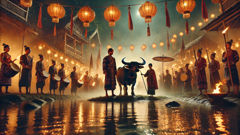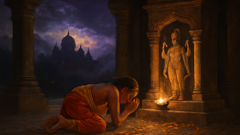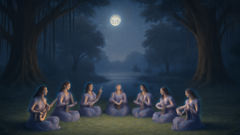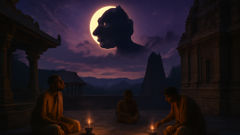Introduction
On the plains and wetlands of ancient Moirang, where reeds bend like the backs of humble elders and the rivers sing the slow old songs, a story lived so fully in the mouths of the people that even the wind learned its cadences. The Moirang Sai—an epic cycle of legend—was not a single tale but a tapestry of moments stitched by time: festivals where drums spoke to the heart, temples where vows were given beneath incense and moonlight, markets where gossip could shape a fate, and fields where children imagined gods as neighbors. At the center of this living tapestry stand Khamba and Thoibi, names that carry the weight of longing and the warmth of belonging. Khamba, an orphan reared by humble kin, grows into a figure of strength and quiet nobility. Thoibi, the princess of Moirang, moves through palace corridors and village lanes with a gaiety that masks a courageous heart. Between them, a thread of love winds—bright, precarious, unrelenting—as if destiny had braided two souls into a single melody. Their adventures become the pulse of a people: contests of valor that test a hero’s honor, dances that seal promises, and sacrifices that reveal the merciless truths of jealousy and power. Yet the story is more than romance; it’s a portrait of a kingdom whose identity is shaped by ritual and memory. From the lacquered boats that cross quiet lakes to the sacred groves where offerings burn like captured stars, Moirang’s landscape is a character in its own right. The Tale of the Moirang Sai that follows is an immersive retelling—rooted in the rhythms of Manipuri life, alive with sensory detail, and shaped to honor both the universality of love and the specificity of a culture that still sings its heroes. Read it as a traveler reads the features of a long map: expect detours into festivals and old rites, pauses at wells of sorrow, and sudden leaps of joy when the lovers meet in secret under a sky that knows both cruelty and mercy.
I. The Making of a Hero and the Birth of a Promise
The early chapters of any great cycle often begin in the ordinary: a hut, a market stall, a child with a handful of rice. Khamba’s origin was modest—a foundling raised by his aged foster-mother, a woman whose hands had learned to weave while whispering prayers to the household shrine. Moirang itself was modest too, a constellation of thatched roofs and narrow lanes, lacquered boats slipping through reed-dotted water, and a palace whose banners unfurled on festival days like bright promises. Yet modesty is not the absence of grandeur; it is its quiet seed.

From the first, Khamba showed an uncommon steadiness. He learned to read the weather like farmers read the earth and to run with a speed that surprised boys twice his age. He hunts in the nearby woods and practices his spear in the dawn, not because he wants renown but because motion seems to teach him who he is. Stories of his skill travel along the river: a fisherman’s wife mentions the boy who rescued a trapped heron, a potter’s son speaks of the time he saved a spinning cart from collapse. These small acts accrue into a reputation. With every retelling, the image of Khamba grows—not as a carved statue, but as a living presence in the minds of people who will need him in days to come.
Thoibi, meanwhile, lives within the delicate tension of privilege and yearning. As the princess of Moirang, she wanders the palace’s cool corridors, her days patterned by ritual. The palace is a world of ceremonies: offerings at dawn, priests chanting in voices that tremble like old ropes, and the constant presence of observers whose eyes measure every gesture. Yet Thoibi’s spirit is restless. She spies markets from high windows, listens to the laughter of women who braided flowers into their hair, and slips away whenever she can to mingle with the people. She learns the folk songs and dances—movements her tutors call improper but she calls truthful.
Their first meeting is small and auspicious. A festival is held at the river—the Thabal Chongba, when music draws the community like tidewater. Lanterns bob; young men play drums; the smell of roasted grains rises. Khamba and Thoibi meet not on a dais but at the edge of the crowd. Their eyes catch on one another as if they recognize something older than themselves. In the shared glance there is neither proclamation nor immediate possession, but a recognition like two flints striking. For the people who witness it, the moment is charged; villagers whisper that the gods have signed the pair’s march.
Court life cannot abide spontaneous matching. Royal suitors are vetted through ceremonies of lineage and politics. Thoibi’s status sets wheels in motion: alliances to consider, names to weigh. Yet love resists neat arrangements. The two begin a private correspondence of glances and small deeds. Khamba leaves woven garlands accidentally on palace gates; Thoibi arranges for a particular song to be played during a feast, knowing that its melody will travel to the edge of town. When news of their attachment reaches influential ears, currents of envy shift the palace atmosphere. There are those who welcome the match—neighbors who have long hoped the princess would marry a humble-hearted man—and those who perceive danger. Stories of the vulnerable have always attracted forces that would harness or destroy them.
The narrative of the Moirang Sai turns upon these tensions. Not all antagonists are villains crafted solely of malice. Some are guardians of custom who fear change; others are aristocrats who see in Khamba a threat to their standing. Court intrigue unfolds with the precision of woven fabric: small knots tightened until cloth is taut. Trials are set before Khamba, some public, some private. He must prove his worth in feats conceived to test more than strength—skill in ritual, grace in dance, a knowledge of customs that mark a true son of Moirang. Each trial becomes a chapter where the people observe and weigh the meanings of worth: is courage merely the ability to wield a spear, or is it the willingness to accept loss to protect what one loves?
Khamba’s answers come in humble heroism. When a wild buffalo rampages near the festival and threatens the crowd, he tames it with steady hands; when a priest misplaces a sacred relic, Khamba finds it beneath a fisherman’s boat and returns it without flourish. These deeds do not silence envy, but they gather admiration. Thoibi’s loyalty is a quiet force, expressed in small rebellions: she disrupts a procession to place garlands on a street performer, she slips a ribbon into Khamba’s hair when he sleeps after a day of training. Their love becomes folklore: tales told by women as they pound rice, by boys as they launch clay boats on the river. It grows into a shared cultural breath.
Beyond their personal trials, the saga reflects Moirang’s spiritual fabric. The land seems to conspire with memory—the lakes hold the names of the dead, temples hum with old ordinances, and the harvest festivals blend gratitude with the need to appease forces less forgiving. In this world, a hero is not only someone who wins battles; he is someone who understands obligations: to kin, to the land, to the unseen. Khamba learns that rites can be weapons or bridges. When the palace council imposes tests, he does not merely meet them physically; he accepts the requirements of ritual intimacy and reclaims respect through humility and a steady adherence to local custom. His victories are seldom solitary; they are shared, mirrored by the townspeople who see in him their own aspirations.
Thus the first part of the Moirang Sai is less a beginning than an awakening. Khamba and Thoibi’s bond is forged through the slow labor of presence: for every grand adventure there are many small acts that stitch them together. The world around them—festivals, shrines, the whispering reeds—becomes the crucible in which their story is tempered. The tale teaches that heroism is as often the refusal to be defined by circumstance as it is the conquest of circumstance itself. And the promise that binds the lovers is not simply a private vow; it is a social contract between individual hearts and communal memory. That contract will be tested by envy, politics, and fate, and it will be sung for generations as the anthem of Moirang’s children.
II. Trials, Betrayals, and the Red Thread of Fate
If the first part of the tale is the slow building of characters and a community’s memory, the second part moves the world forward with harder winds. Tales that endure are those that do not spare their protagonists the severe lessons of jealousy and miscalculation. Once Khamba and Thoibi’s attachment becomes common talk, the palace’s social calculus falters. Power listens like a hound; when it smells a threat, it circles. Those who benefit from the established order—chiefs of lineage, ambitious relatives, and a few jealous nobles—conspire to limit Khamba’s ascent. The stories that some scribes of the court prefer to write are those of decorum kept and challenges repaid. But destiny, in Moirang fashion, is messy: it makes room for both cunning and compassion.

The conspiracies begin as small slights. A favor denied at a feast. A carefully leaked rumor about Khamba’s lineage. Someone plants a charge that he is not of pure descent and thus unfit. In a society where lineage governs rank, such insinuations can be fatal. Thoibi’s defenders rise—women of the market, a few sympathetic courtiers, and humble men who have watched Khamba’s quiet deeds. Yet conspiracy finds purchase among those whose authority depends on a predictable order. To silence the dissenting romance, the council imposes greater trials—tests meant to humiliate and exclude. Some are martial: an arranged hunt where success will produce symbolic ownership of land; others are ritual: recitations that prove one’s intimate knowledge of lineage and sacred rites.
Khamba’s responses are shaped by an internal code that puts honor above complaint. He enters the contests not with fury but with focused determination. In the great boar hunt—a trial designed to elevate aristocratic prowess—Khamba’s courage and skill save lives; when an elite hunter is injured, Khamba is the one who steadies him and then refuses to take credit. This further confounds his enemies: his humility acts like a mirror that reveals their pettiness. Public admiration grows, and yet so does jealousy. The palace becomes a theater where public acclamation and private resentment dance a complex jig.
Betrayal sharpens when those closest to the corridors of power stake their fortunes on breaking the lovers. An arranged match is proposed to Thoibi, not for love but to consolidate power with another noble family. She is pressured to accept, and the palace drums demand obedience. Thoibi’s bravery is tested in ways beyond the spear and dance: she must decide whether to follow royal duty or to follow the small, stubborn compass of the heart. She performs her duties with the graceful composure expected of royalty while finding small opportunities to resist—letters exchanged under the cover of night, messages hidden in embroidery, stolen moments on riverbanks where the moon witnesses their plans.
As pressures mount, Khamba learns a more painful lesson: love in a world of hierarchies is seldom secured by victories alone. Sometimes the enemy is not a rival but an institution of expectations. To counteract the palace’s designs, Khamba embarks on a series of quests both public and private. He seeks allies in unexpected places—the boatmen whose knowledge of the lagoons offers him secret routes, the aged storytellers who keep unrecorded oaths, and a priestess whose counsel helps him navigate the rituals that the council uses as traps. Each ally contributes not only practical help but cultural legitimacy: they remind the kingdom that worth does not always issue from pedigree. The people who have watched Khamba grow add their voice to his cause; when the ruler hesitates, it is the public murmur that becomes thunder.
The tale’s darker turns come not only from politics but from fate and misinterpretation. Misread omens and maliciously altered prophecies set the stage for a tragedy that will be sung for centuries. At a critical juncture, a ritual is performed meant to secure a bountiful harvest and, by extension, seal a promise of a union. Yet the ritual is tampered with—an ingredient misplaced, a verse altered. The consequences are catastrophic in the symbolic terms of the time: a sign that the gods are displeased, and therefore the union cannot be sanctioned. In a society where the metaphysical informs governance, such an omen is a weapon. Thoibi is pressured to recant her attachments and to accept the arrangements the palace devises. The lovers face a choice: to obey public ritual or honor private truth.
When tragedy finally arrives, it does so as a sequence of small cruelties amplified into irrevocable consequence. A planned elopement falters because a liaison is discovered; a message is misdelivered; an ally is bribed or threatened. The sequence of errors has the terrible logic of a Greek chorus—each new misstep is both its own sorrow and the cause of deeper sorrow to come. Khamba and Thoibi are forced into roles they neither wanted nor entirely understood. Their sacrifices are individual and collective. Friends are lost; reputations are tainted. The people of Moirang, who had once cheered Khamba’s triumphs, now watch as the tale’s momentum bends toward sorrow.
Yet even amid betrayals and misfortune, the Moirang Sai refuses to be merely tragic. There are moments of luminous resilience: villagers who keep vigil, old women who recite the couple’s names to newborns as talismans, and children who invent games based on their exploits. In these acts of remembrance, the legend deepens. Love here is not an ephemeral private glow but a public ember that people tend. Where the palace fails, the community preserves. The narrative therefore holds two contrasting truths at once: that institutions can crush tenderness and that communal memory can resurrect it. It is in this dialectic—destruction and preservation—that the True Work of Moirang unfolds.
As the legend reaches its fevered climax, the lovers’ final choices become sacramental. Whether through death, exile, or a mysterious merging with the sacred landscape, Khamba and Thoibi’s fates transcend the petty claims of power. The story’s final image in many versions is not merely an end but a metamorphosis: their names enshrined in the songs that mothers hum, their deeds painted on masks used in ritual dance, their story woven into cloth that adorns the temple altars. The cycle closes like a ring because stories in Moirang are meant to be passed, not finished. Each generation retells the tale with fresh emphases—sometimes on courage, sometimes on faithfulness, sometimes on the need to resist unjust authority. This mutability is the legend’s lifeblood.
The Moirang Sai thus becomes both mirror and map: a mirror reflecting a people’s values back to them, and a map showing how to travel the dangerous geography of honor and love. The red thread that binds Khamba and Thoibi may fray in places, but it does not break. Even when the palace changes its colors and the rulers forget, the folk remember. In that memory, Khamba and Thoibi continue to move—on riverbanks, in children’s games, through the slow drumbeats of festivals—reminding Moirang that some promises endure precisely because they are shared by the many, not hoarded by the few.
Conclusion
Legends endure because they do not simply tell what happened; they show how people remember and why. The Tale of the Moirang Sai—Khamba and Thoibi’s story—is, at its heart, a testament to the power of communal memory and the fragile, stubborn courage that love requires. In Moirang, the lovers’ names become more than proper nouns; they become verbs, like ‘to Khamba’ meaning to act with steady-hearted bravery, or ‘to Thoibi’ meaning to hold a quiet, compassionate defiance. Their outcomes—whether tragic, transcendent, or somewhere between—are less important than what the community chooses to carry forward. Over generations their story has been dressed anew: in dance, embroidered cloth, ritual enactment, and whispered legend. It teaches that rites bind people as much as power does, that a single courageous act can shift the currents of history, and that the land itself keeps the memory of those who loved it well. As you leave this tale and return to your daily roads, carry with you a small piece of Moirang’s riverside: the idea that heroism need not always be loud, that love often requires impossible patience, and that the stories a people choose to treasure are the ones that shape who they will become. The Moirang Sai invites you to listen—closely—to the drums, to the reeds, and to the low, persistent hum of memory that keeps legends alive.













